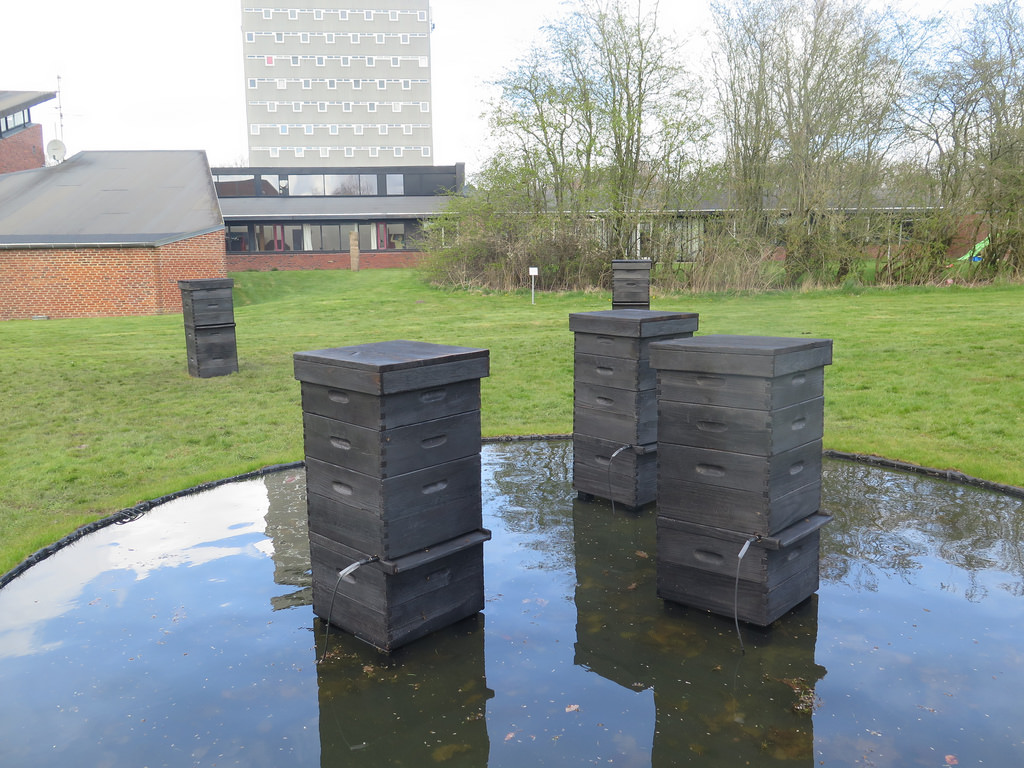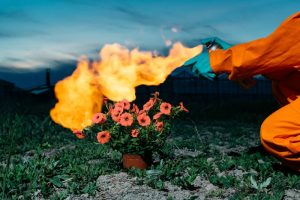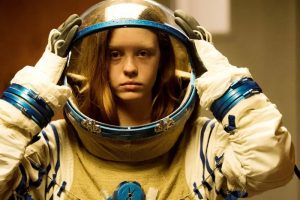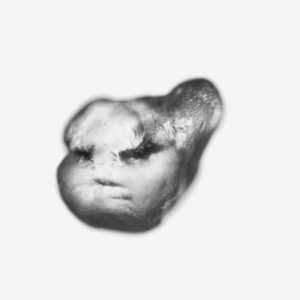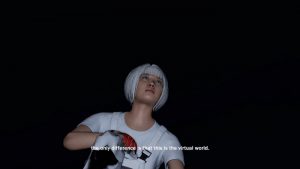Previously: Breeding a Planetary Community Chicken and Socle du Monde Biennale – The geometries.
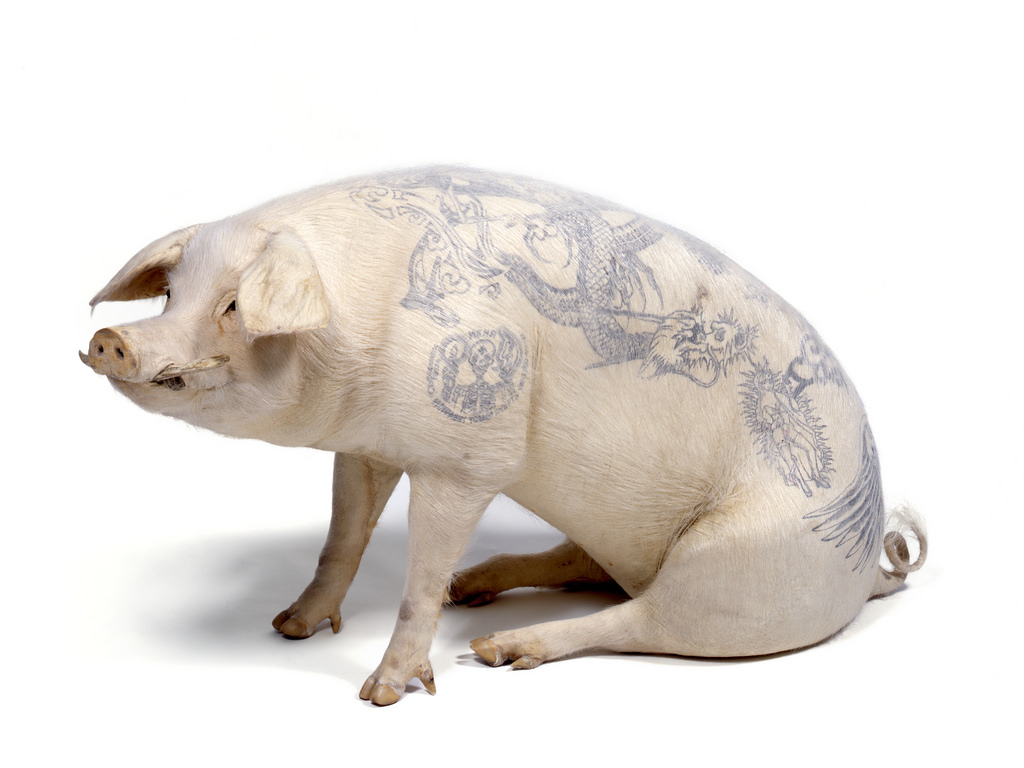
Wim Delvoye, Slobodan, 2004. Photo courtesy of the artist
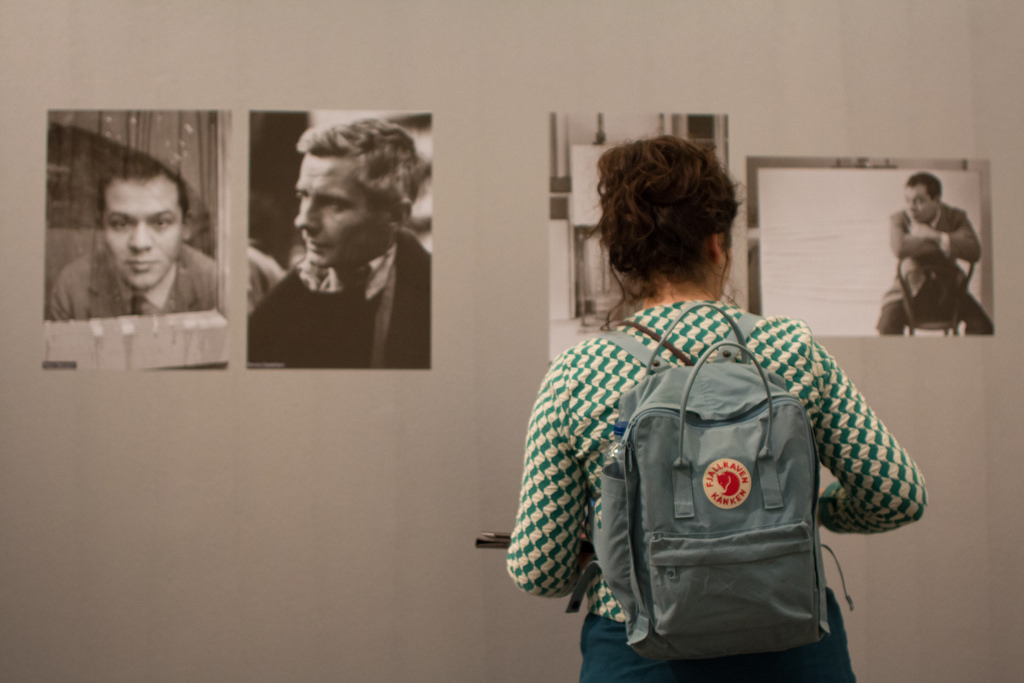
Exhibition view. Photo: Jens Wolter
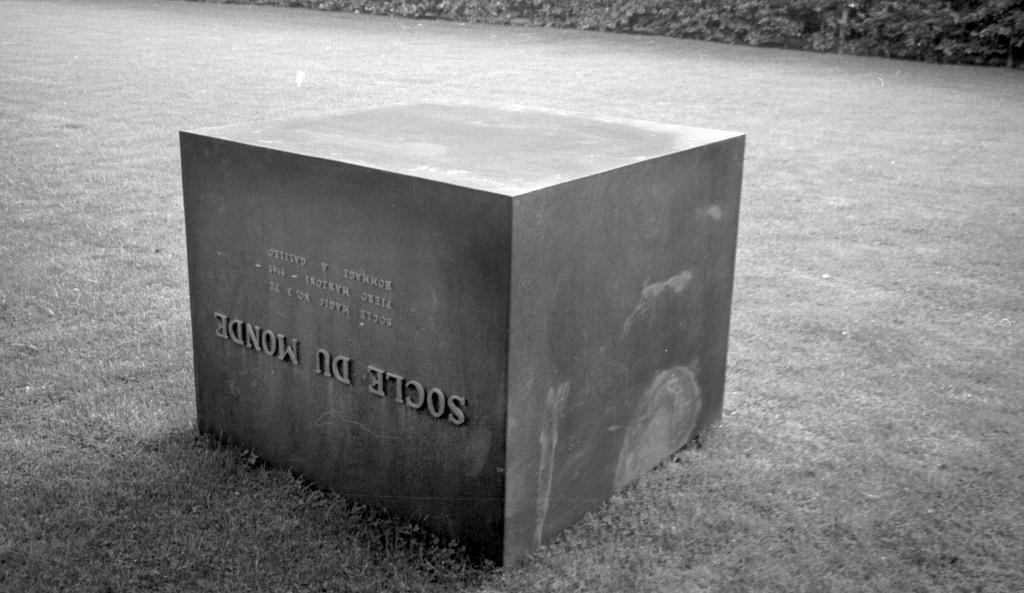
Piero Manzoni, Socle du Monde, 1961. Photo: Ole Bagger. Courtesy of HEART – Herning Museum of Contemporary Art
Socle Du Monde – To challenge the Earth, the Moon, the Sun & the Stars, the biennale that opened a few weeks ago in Herning (Denmark), celebrates artists who have taken up “the challenge of turning the world upside down”. The event is named after a famous work by Piero Manzoni, the upside-down plinth that invites viewers to look at their surrounding from a new perspective and see the world as the ultimate artwork. Some of the pieces exhibited in the biennale are by Piero Manzoni and fellow artists who were part of ZERO, a movement in the 1950s and 1960s that looked for a ‘fresh start’ in art by eschewing color, emotion and individual expression. Visually, it might be a bit beige and tedious but a closer look reveals ingenious experiments with light, forms, space, materials and time.
Most of the biennale, however, is inhabited by contemporary robots, musical insects, animals, tattoos, African masks and tree trunks wrapped up in fabric. Just like what happened (to me) with the ZERO works, it’s tempting to stop at the first visual impression and skip from one artwork to another. However, it pays to read the description of each work and understand the ideas and beliefs behind each installation. That’s how you realize that even the most garish fairground signs have the power to make you ponder upon civic values. Or that a few farm animals can teach you a lesson about our relationship to non-human creatures. That’s also how you’re going to spend almost 6 hours visiting the biennale, instead of the 2 hours suggested by the event online guide. Also by the time you’ve visited all the exhibitions and the huge sculpture park, you might not have much strength left to skip and hop anyway. Slow and serene is the way to do it.
The city of Herning is probably not an obvious Summer destination but if ever you find yourself in the area, do check out the biennale, it is one of the most consistently surprising, intelligent and visually compelling art events i’ve seen this year. Here’s a short and very subjective list of some of the works you can discover at Socle du Monde:
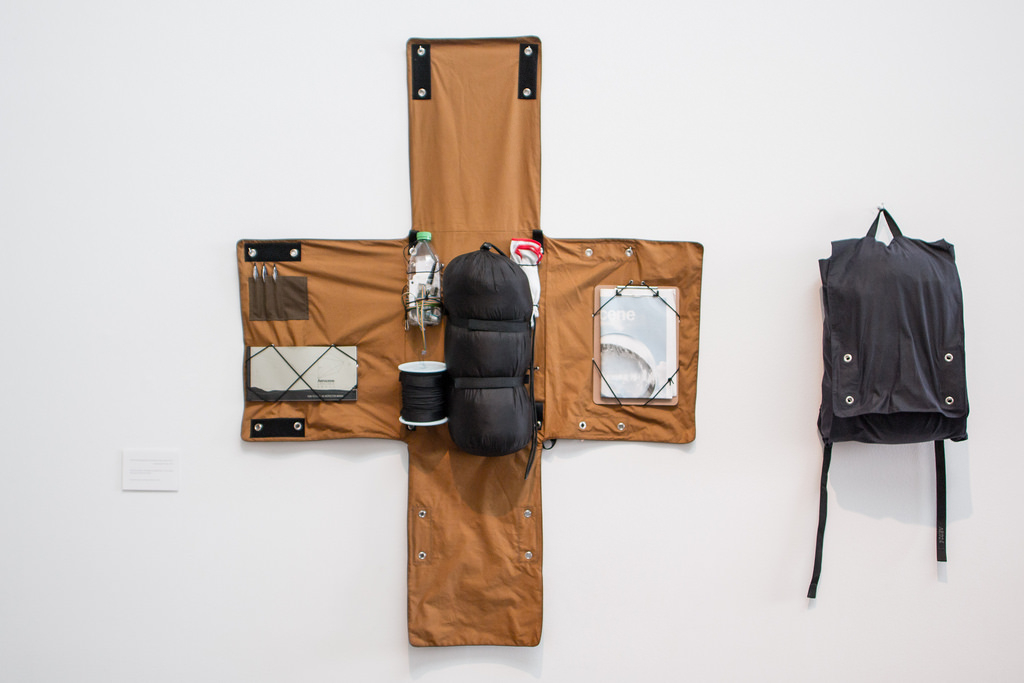
Tomás Saraceno, The Aerocene Explorer. Photo: Jens Wolter
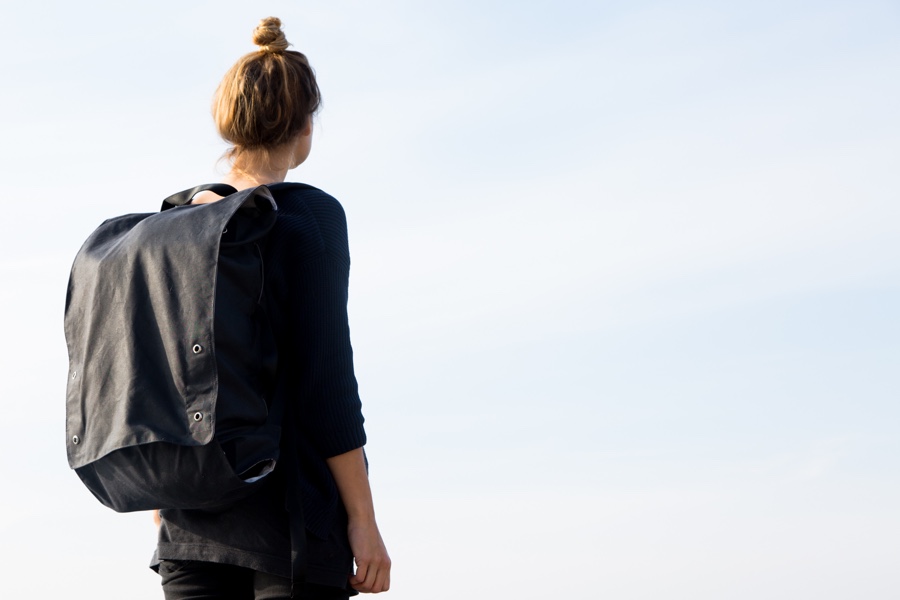
Tomás Saraceno, The Aerocene Explorer backpack. © Photography by Studio Tomás Saraceno, 2016
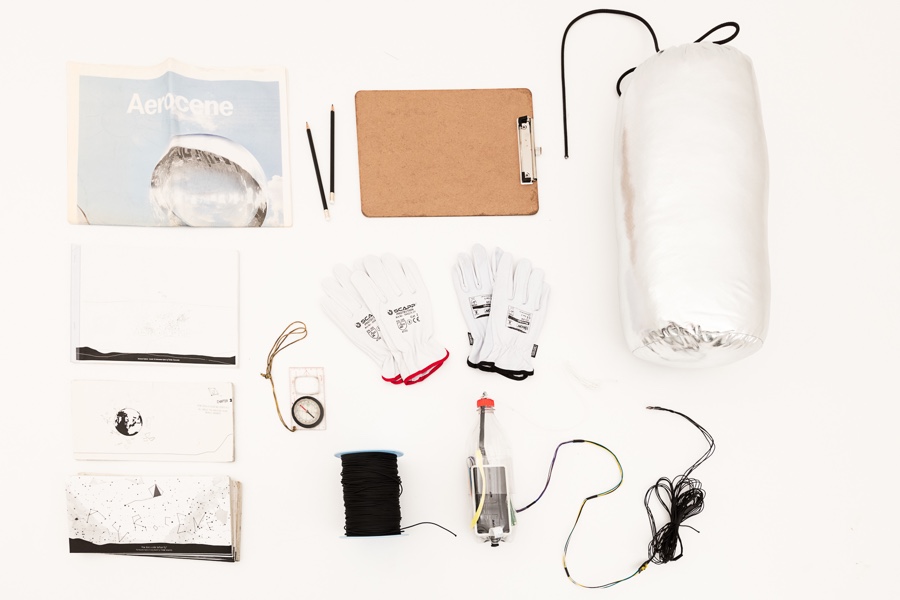
Tomás Saraceno, The Aerocene Explorer backpack. © Photography by Studio Tomás Saraceno, 2016
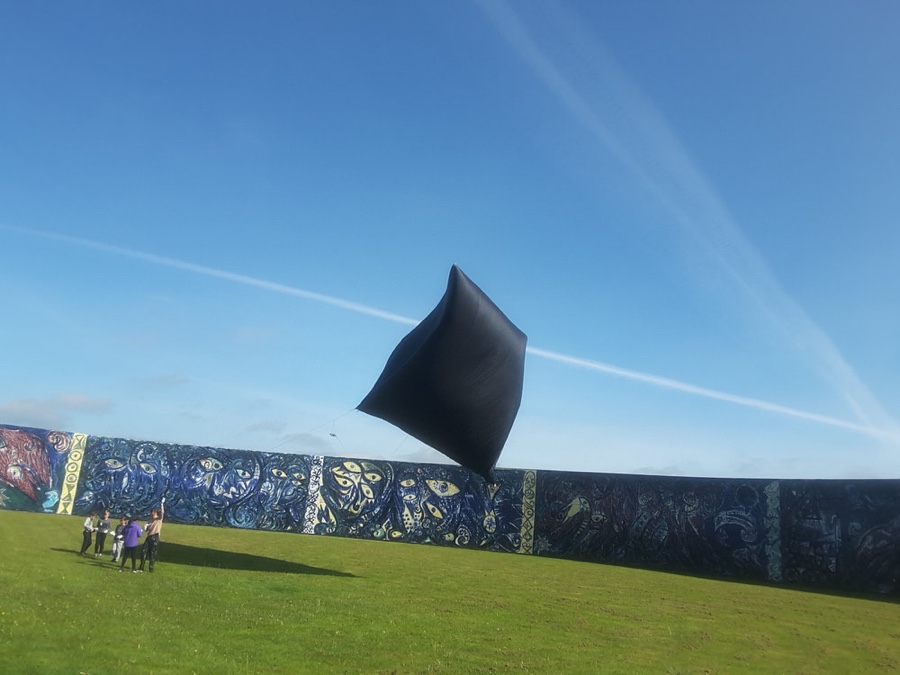
Tomás Saraceno, The Aerocene Explorer. Image HEART museum
Tomás Saraceno is embracing “the Earth, the Moon, the Sun & the Stars” rather than challenging them. The artist has spent the past few years designing for the Aerocene era, a speculative CO2-free future in which humans will live in floating habitats, clustering together and peacefully defining new forms of social structures and citizenship.
The artist created a beta version of the Aerocene Explorer backpacks to help us reclaim collective ownership of the atmosphere. The floating sculpture doubles as kit for solar-powered atmospheric exploration. It is open source and you can DIY yours should you wish to explore the skies too.
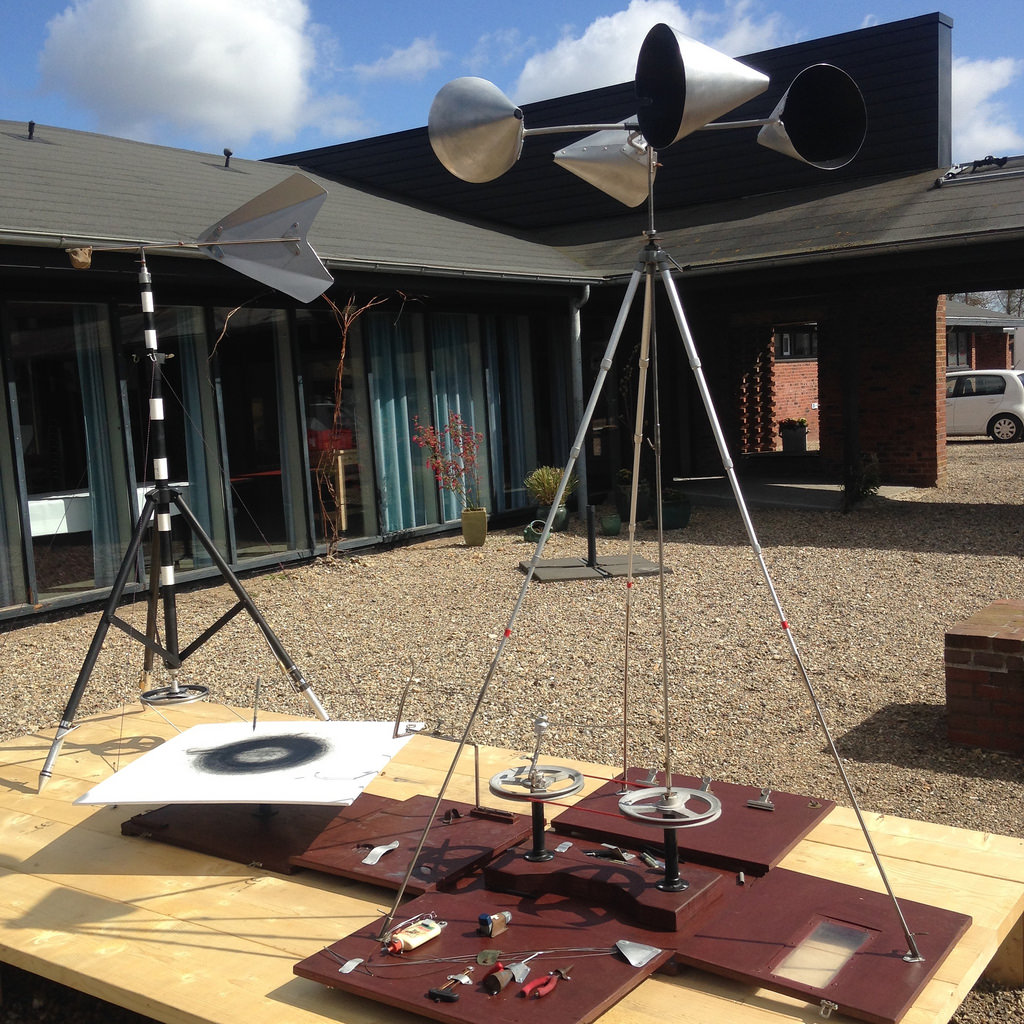
Cameron Robbins, Wind Drawing Machine, 1990-2016
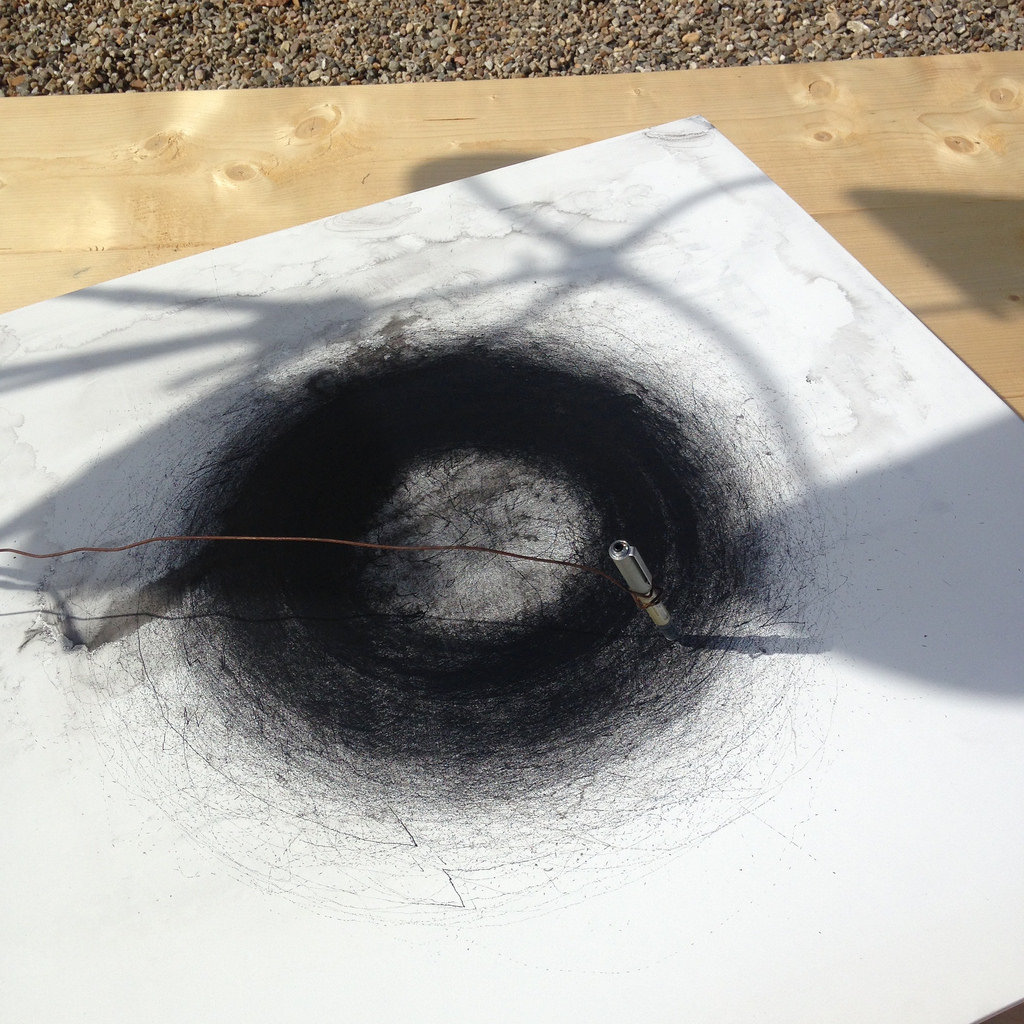
Cameron Robbins, Wind Drawing Machine, 1990-2016
Cameron Robbins‘s Wind Drawing Machine also harnesses weather energy. Only it translates it into abstract ink drawings. Wind speed and direction orients a swiveling drawing board connected to a wind vane, while the wind speed drives a pen on a wire arm around in a cyclical motion.
For many years Robbins has been crafting elegant drawings machines that are guided by the wind. Some of these machines draw with light. Others participate to sonic performances.
“I had found a way of working with the world,” he explained in an interview, “that reflected my observations and was my own thing. For me it also offered a nice sidestep over vexing issues like self-consciousness in art making.”
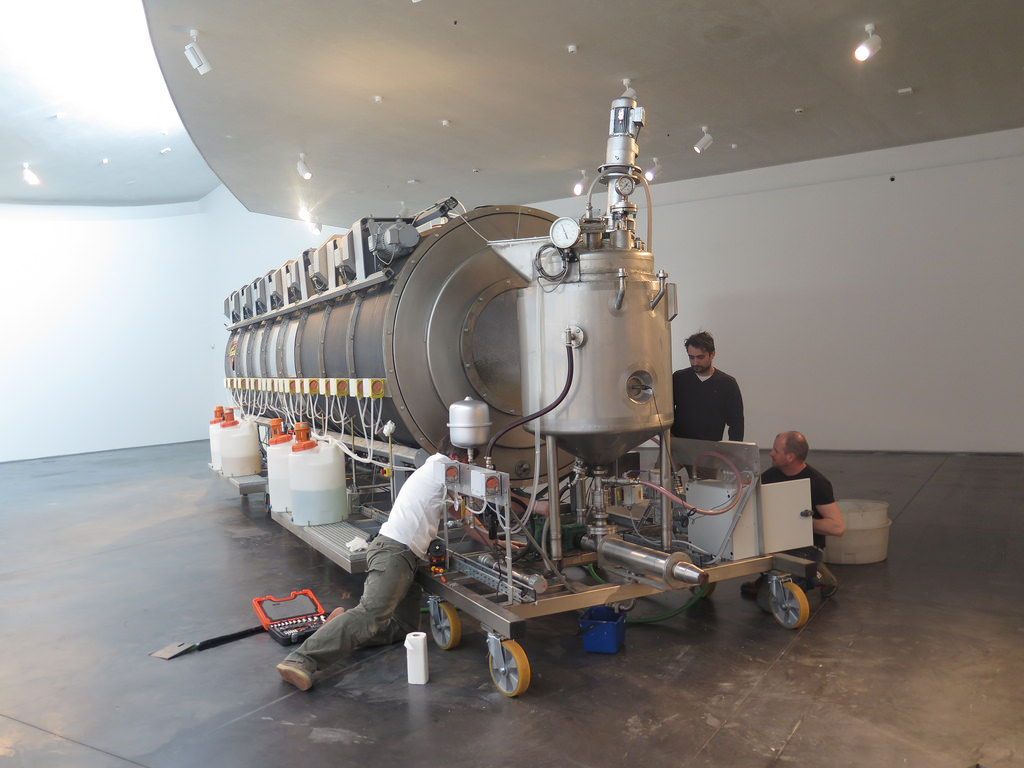
Cleaning up Wim Delvoye’s Super Cloaca
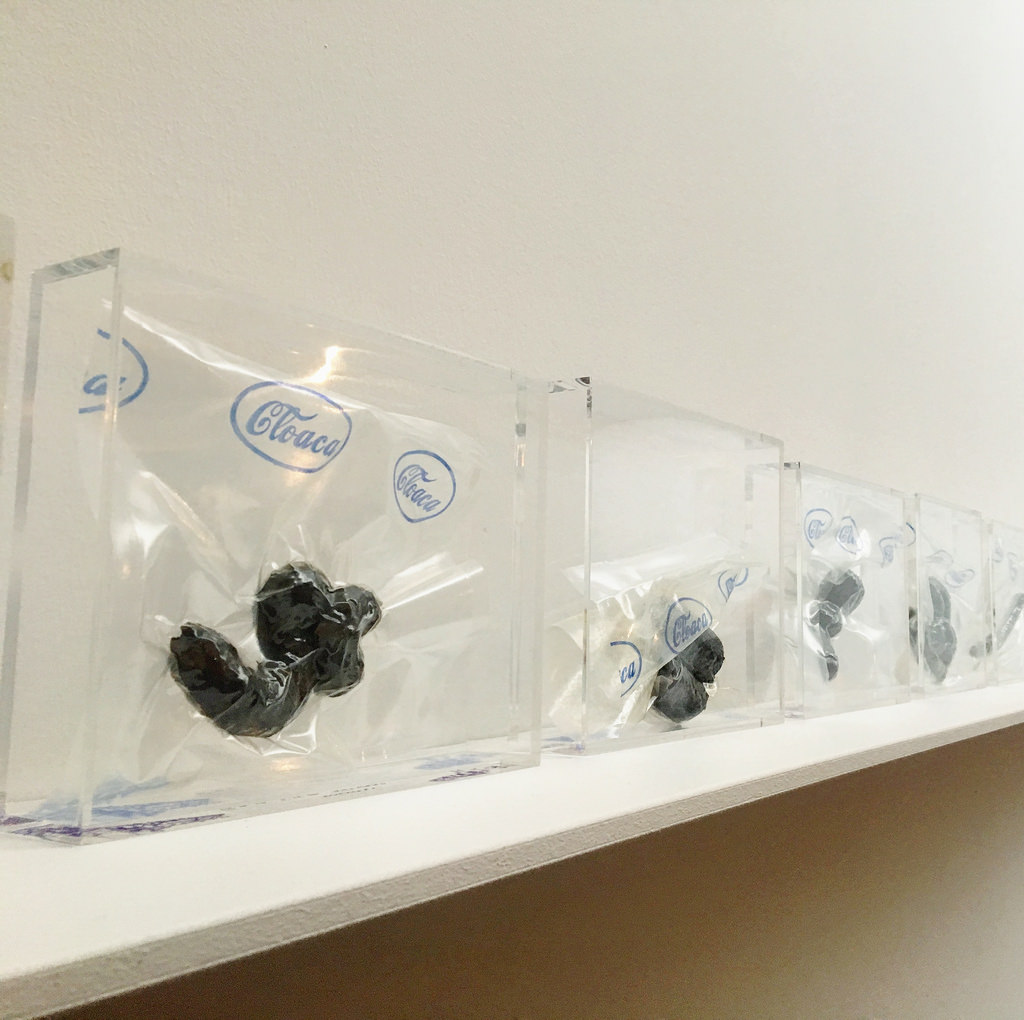
Wim Delvoye, Cloaca Faeces. Photo: Jens Wolter
One of the chapters of the biennale is tastefully titled Wim Delvoye: Shit on Piero Manzoni. It’s a little horror show orchestrated by the famous provocateur: anus prints, a video that zooms in on blackhead extraction, and a shit machine complete with its smelly production. Wim Delvoye has made several versions of Cloaca. There’s one you can squeeze in a suitcase, another that is hanging on the ceiling of a museum in Tasmania, another looks like a washing machine, etc. The one on show at the HEART museum is Super Cloaca, a huge technological simulation of the human digestion. On one side, you feed the machine and a few hours later a long sausage made of faeces is extruded. I arrived at the museum at the worst possible moment: the shit had been delivered a couple of night earlier and the staff was cleaning up the machine. The smell was awful.
The artist’s declared objective was to build an expensive, sophisticated apparatus that would have no other purpose than producing shit. Yet, the work does invite numerous questions about the value of artistic efforts, taste-based judgments, human hierarchies and even the mechanisms that support the art market. You can’t buy any of these machines but you can buy what they expel. Delvoye’s team will vacuum-pack it and seal it in a small jar of resin for you.
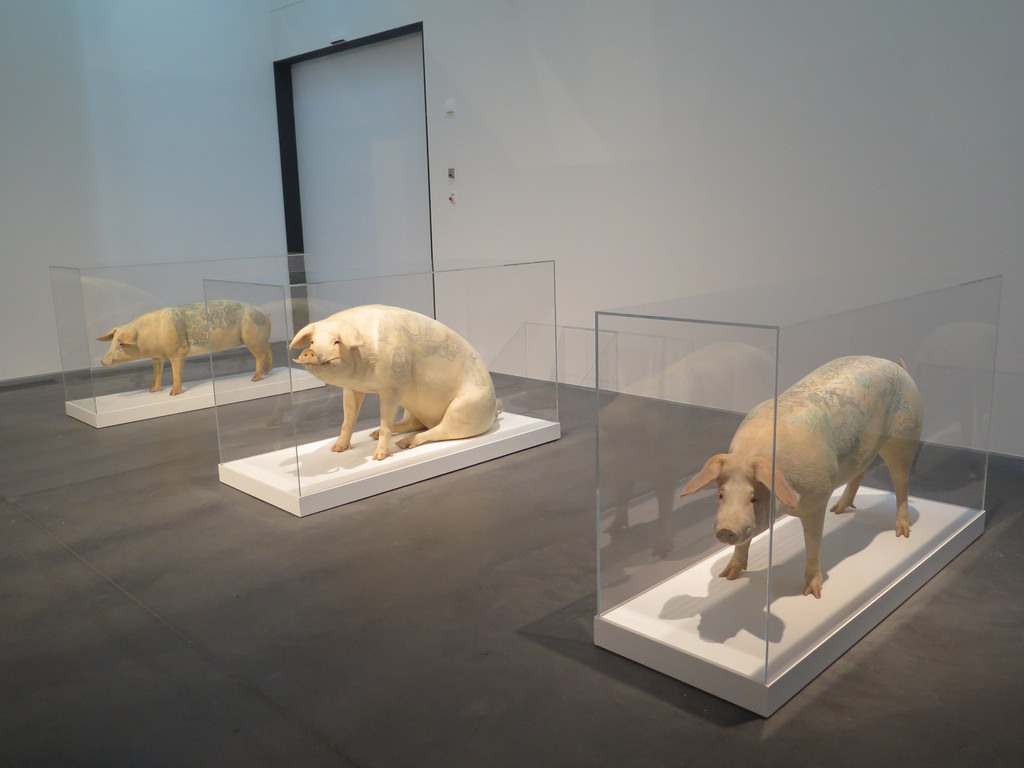
Wim Delvoye, Tattooed Pigs
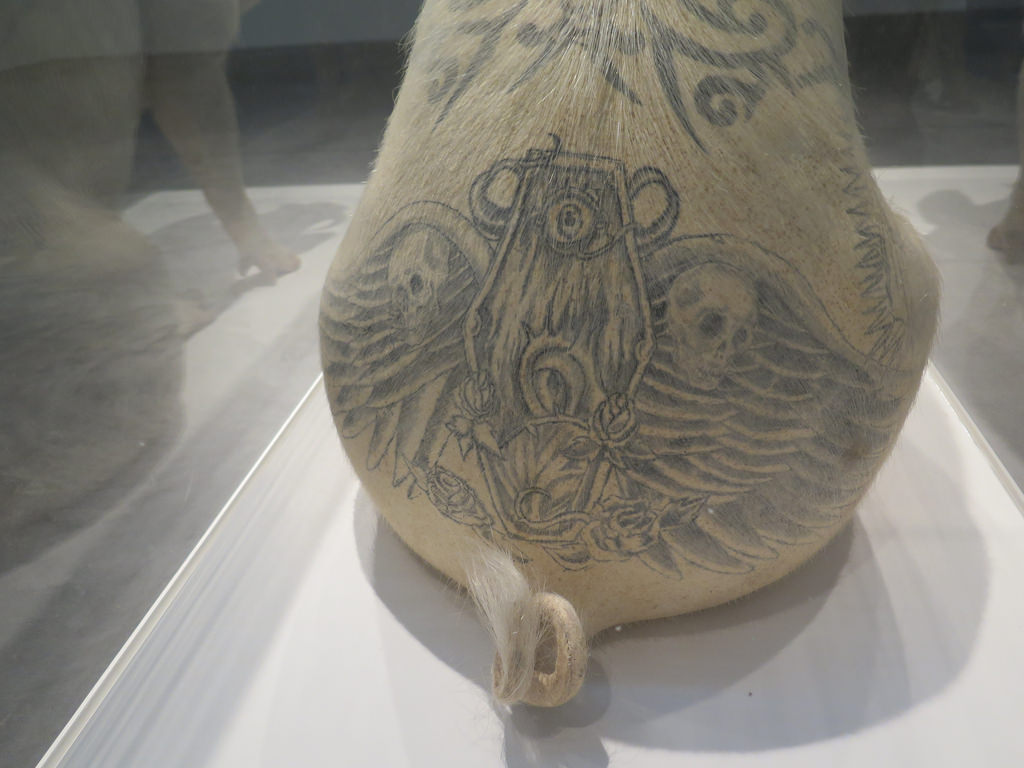
Wim Delvoye, Tattooed Pigs
Delvoye also brought some of the tattoed pigs from his controversial Art Farm. Their taxidermied bodies are covered in hearts, leggy ladies, wings, skulls, Disney characters, Louis Vuitton monograms and religious symbols.
As an insightful article in the brooklyn rail notes: The images in this case fleetingly bolstered the physical worth of the animals while concurrently exposing the contradictions in our value system. For example, the tattooing required a special veterinary anesthesiologist because while we have procedures developed for the sedation of dogs, cats, and giraffes, pigs are not worth enough to fix if something goes wrong. But imbued with the aura of their artist decorator, the skins in which the pigs lived conferred upon them an elusive fetishized value. This value did not extend to the flesh, as the animals were skinned and their meat sold at market price.
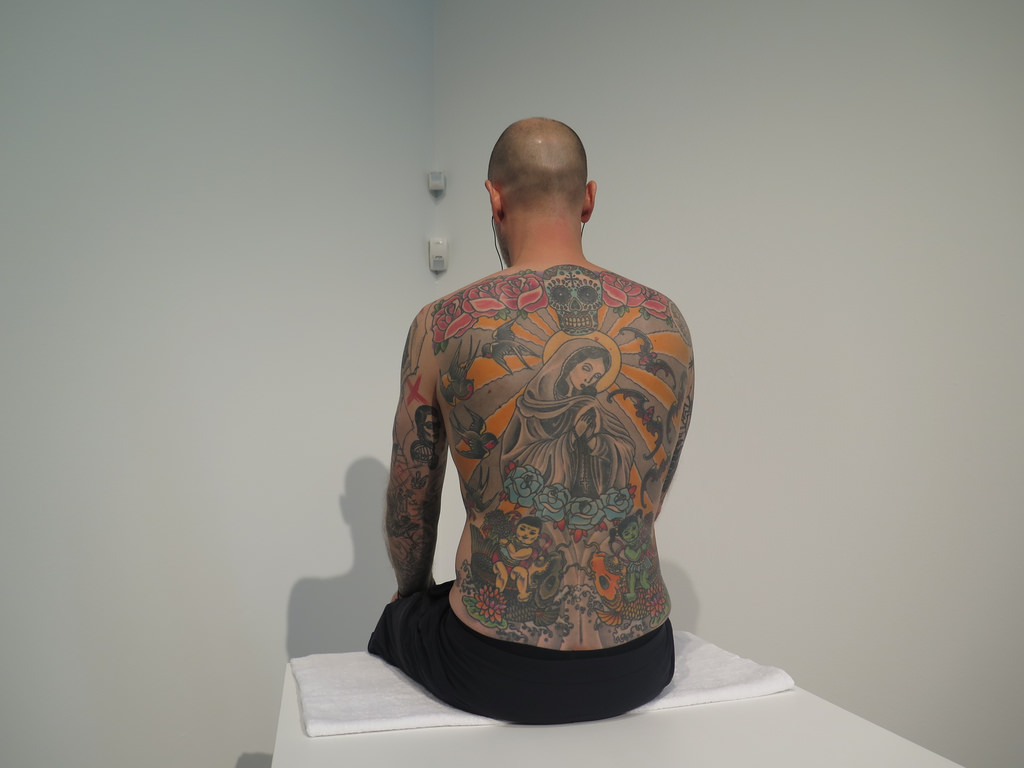
Wim Delvoye, Tim, 2006-2008
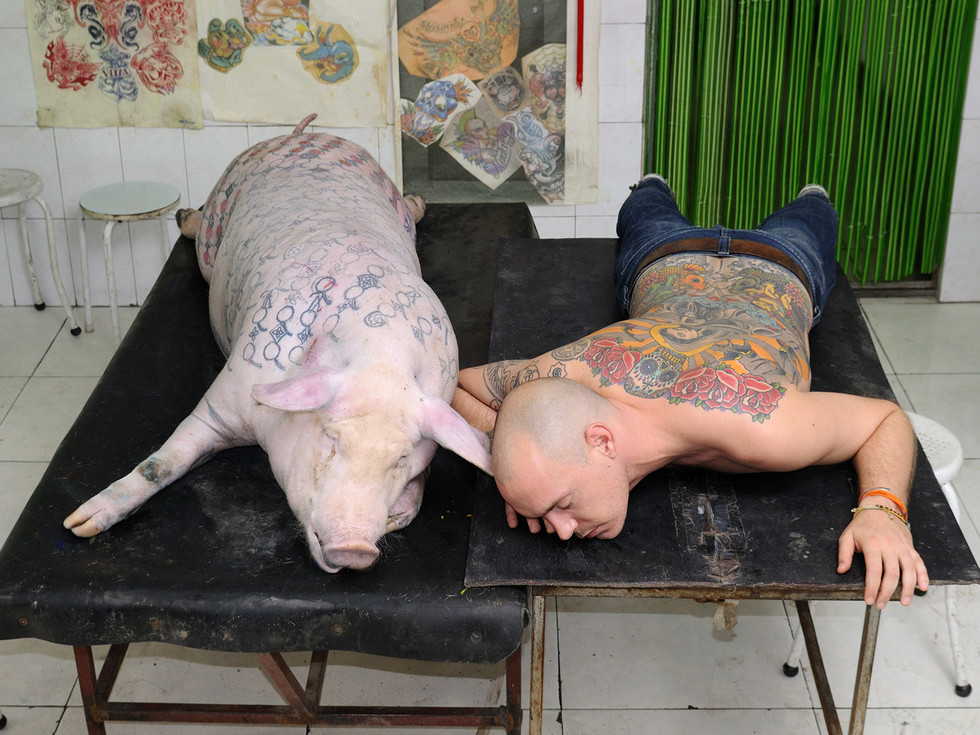
Wim Delvoye, Tim, 2006-2008. Photo courtesy of the artist
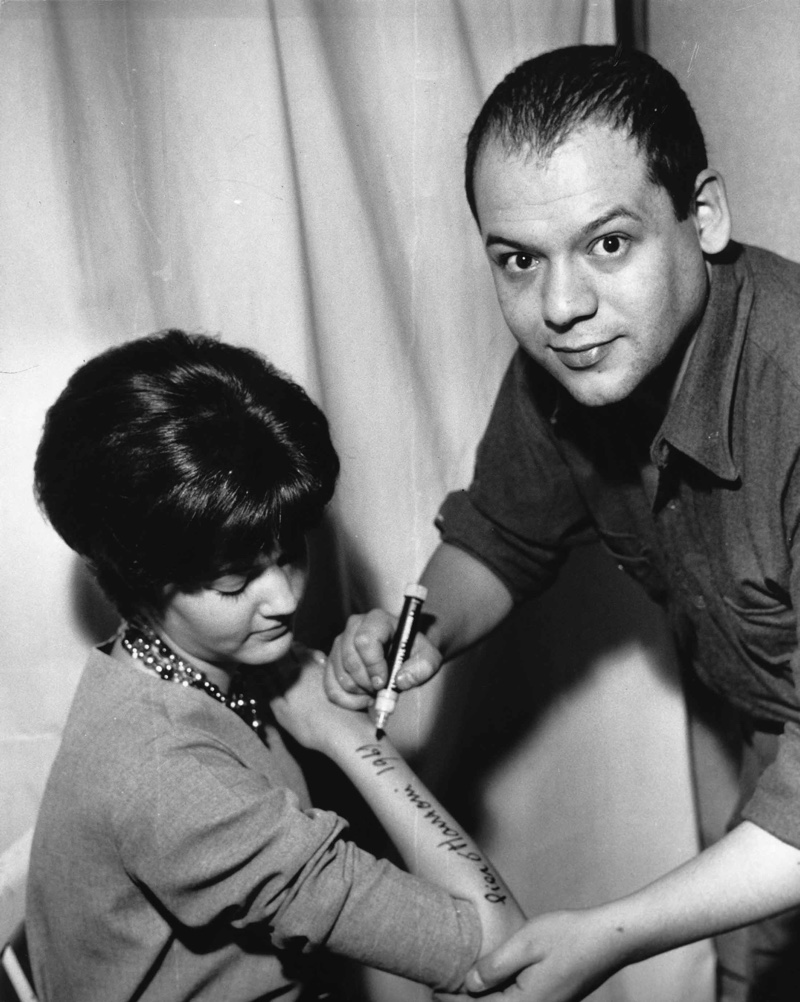
Piero Manzoni, Living Sculpture. Photo: Ole Bagger
And finally, there was Tim! Tim is “a living sculpture”. Delvoye tattooed his back and has since sold it to a German art collector. When Tim dies, his skin will be framed. In the meantime, he’s paid to sit, with a straight back and legs dangling off on a plinth. Fortunately for him, he is allowed to keep his headphones on…
Tim echoes Manzoni’s ‘living sculptures’, models whom the young artist signed with ink that could be washed off, making them temporary artworks.
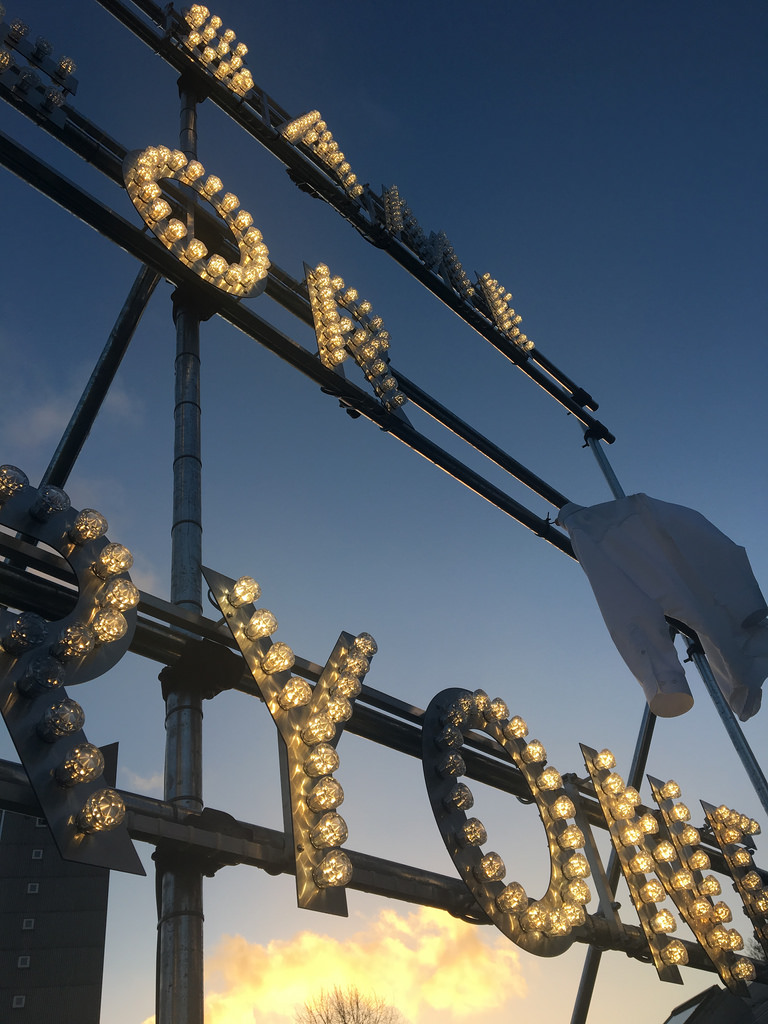
Nathan Coley, The Same for Everyone (detail), 2017. Photo: Jens Wolter
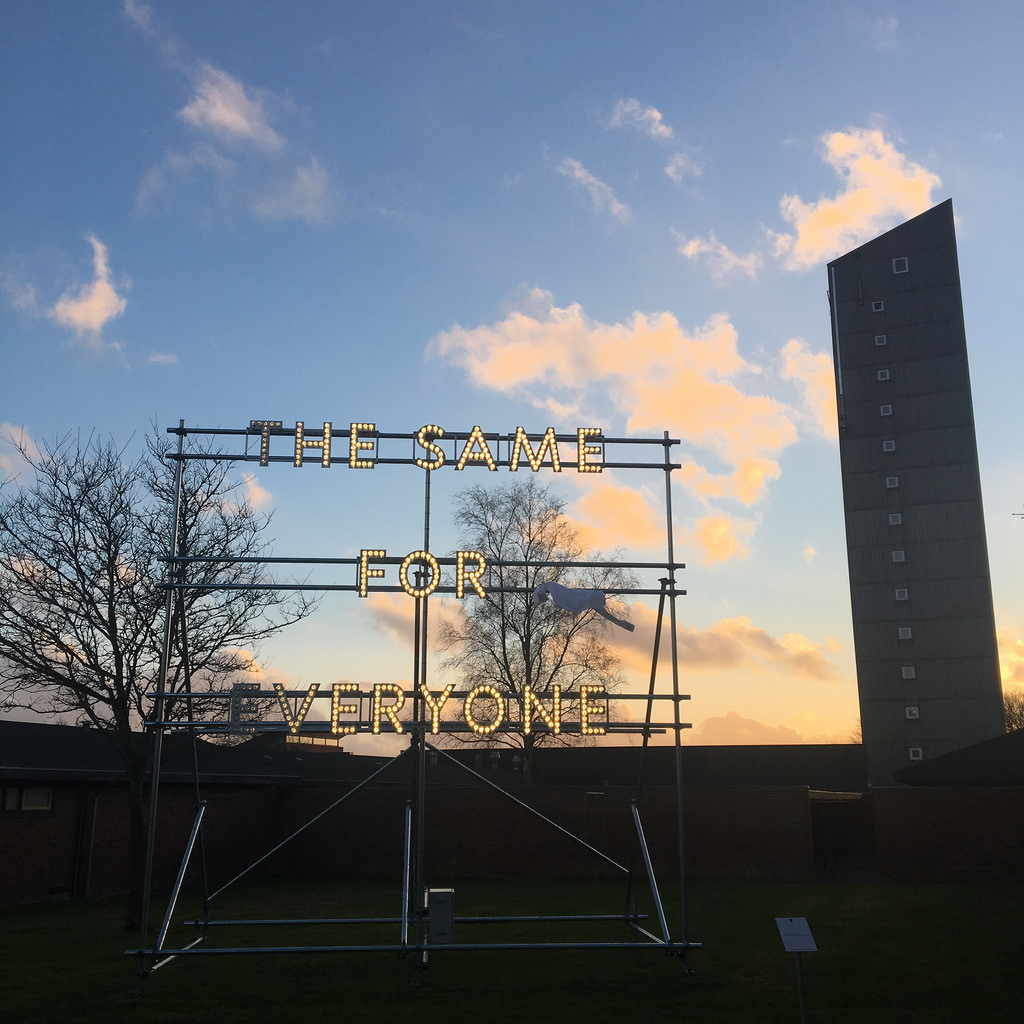
Nathan Coley, The Same for Everyone, 2017. Photo: Jens Wolter
Artist Nathan Coley was traveling through Central Jutland, when he saw an old sign reading ‘Same for all’. Hence his collection of signs, THE SAME FOR EVERYONE, which have been erected ten locations around Jutland. One of them is just outside one of the locations of the biennale.
I love that work. Because of the old school bulbs and scaffolding aesthetics. But also because of the text. First, you think you get the meaning immediately. But the more you think about it, the more complex its possible meaning seems to get. Or maybe i like to complicate things?
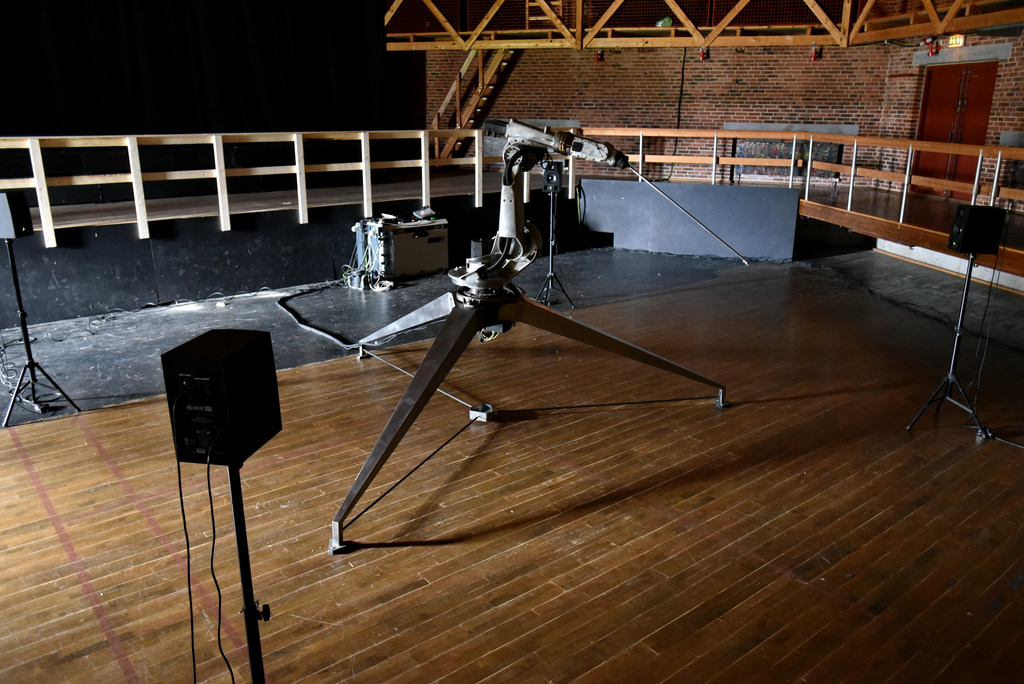
Conrad Shawcross, The ADA Project. Photo: Ole Jørgensen
Conrad Shawcross’s The ADA Project is an industrial robot, its choreographed movements inspired the composition of musical scores written by composers. The performances look quite different from what the official images of the work suggest. The machine moves far too slowly for its arms to draw those stunning patterns of light. If you’re used to media art festivals, you’re not going to be very impressed. However, i think that the value of The ADA Project lies in the development process of the work. The artist commissioned female musicians to spend a week with the robot and write a piece of music inspired by its movements. “I’m trying a new way of commissioning with new constraints,” Shawcross told The Guardian. “The key tenet was that instead of the machine being subservient to the music, the machine was the primary inspiration.
The title of the work is an homage to mathematician Ada Lovelace, who played a key role in the development of computer programming.
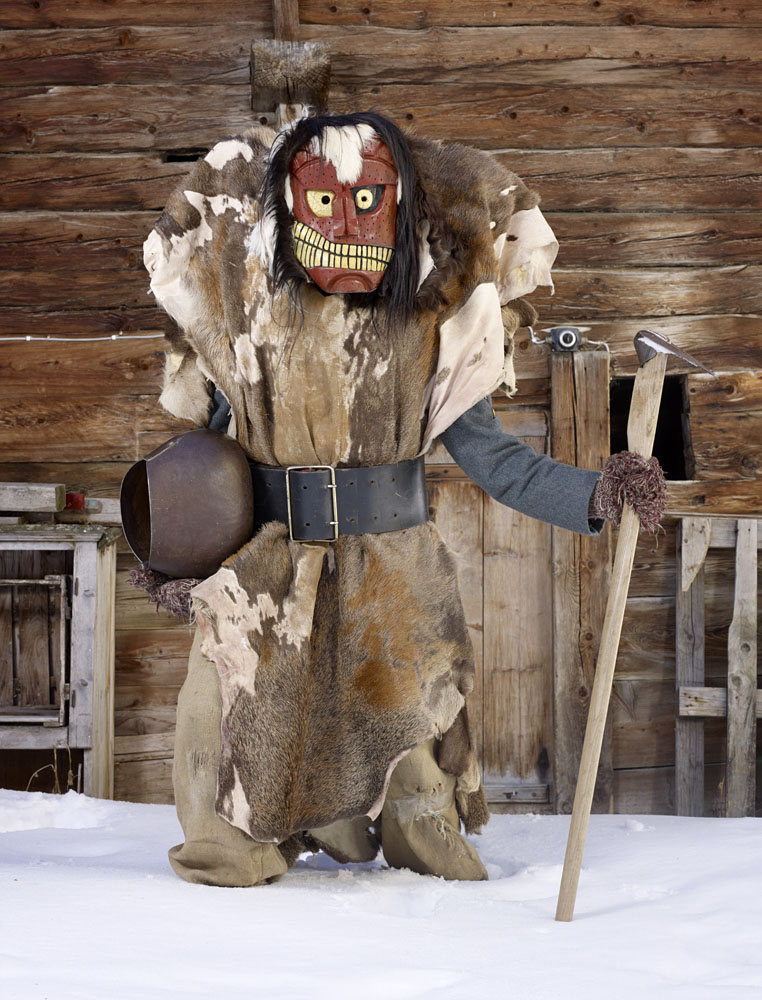
Charles Fréger, Wilder Mann (Tschäggättä, Switzerland), 2010-2011
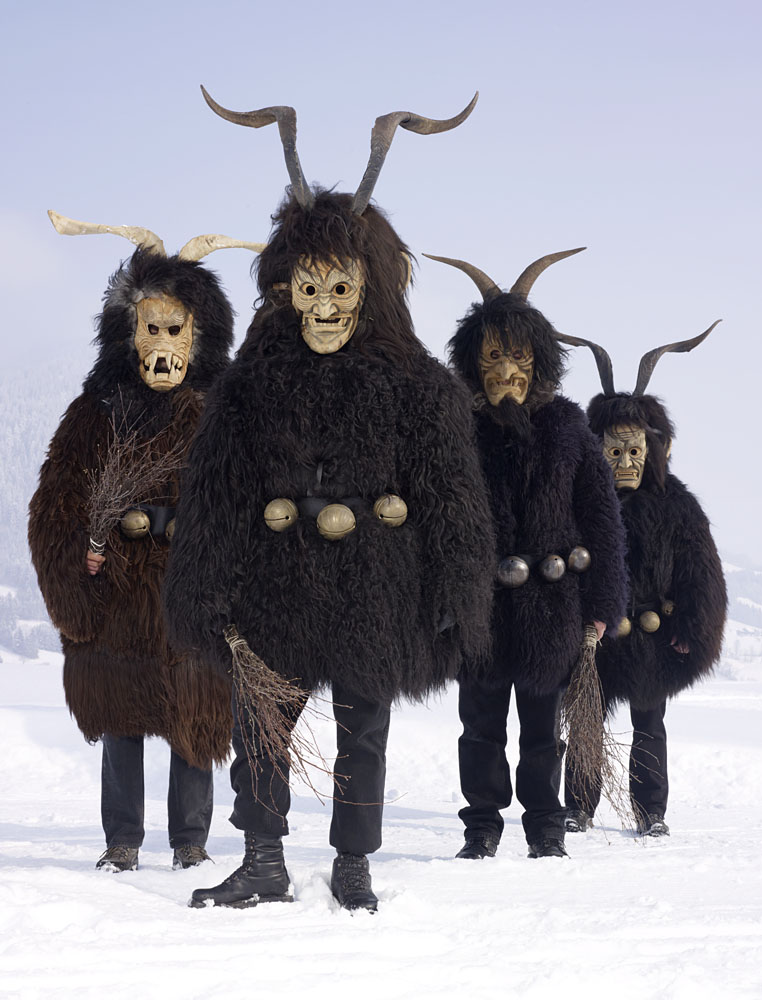
Charles Fréger, Wilder Mann (Krampus, Germany), 2010-2011
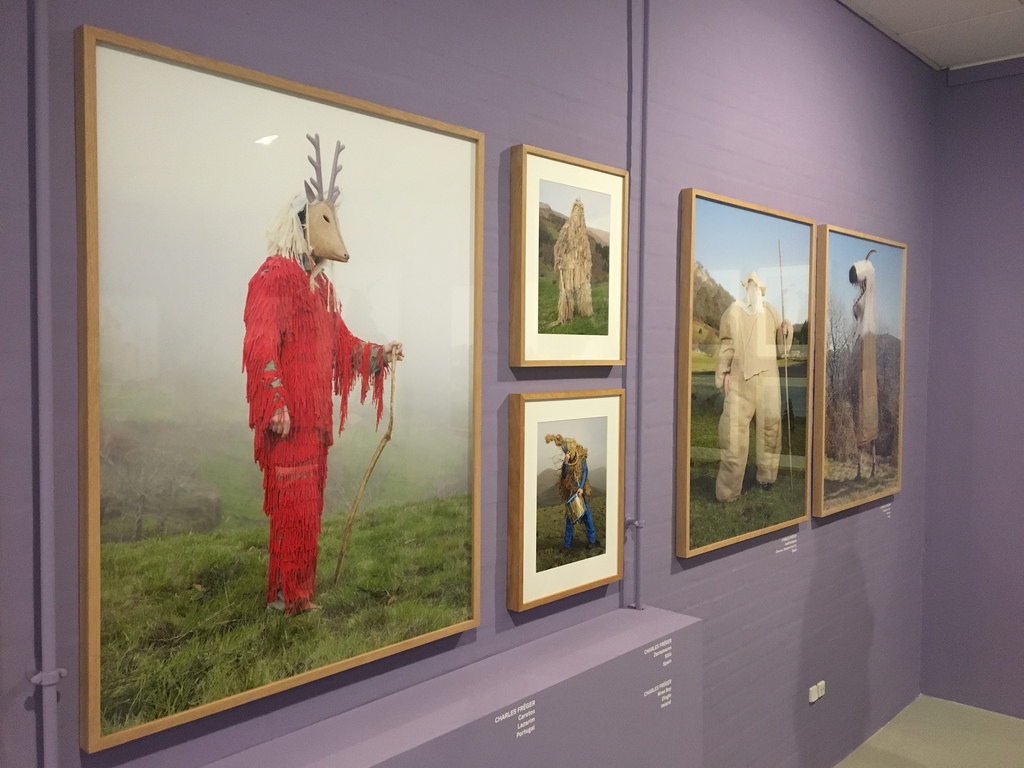
Charles Fréger, Wilder Mann, 2010-2011. Exhibition view. Photo: Jens Wolter
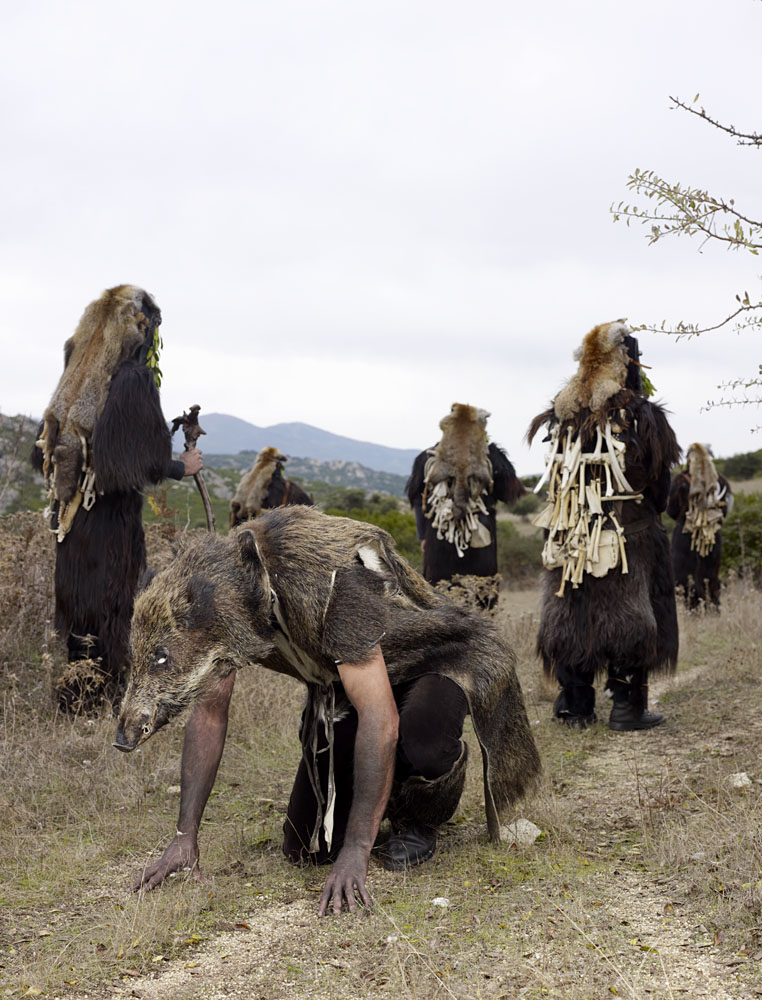
Charles Fréger, Wilder Mann (Sos Colongànos, Sardinia), 2010-2011
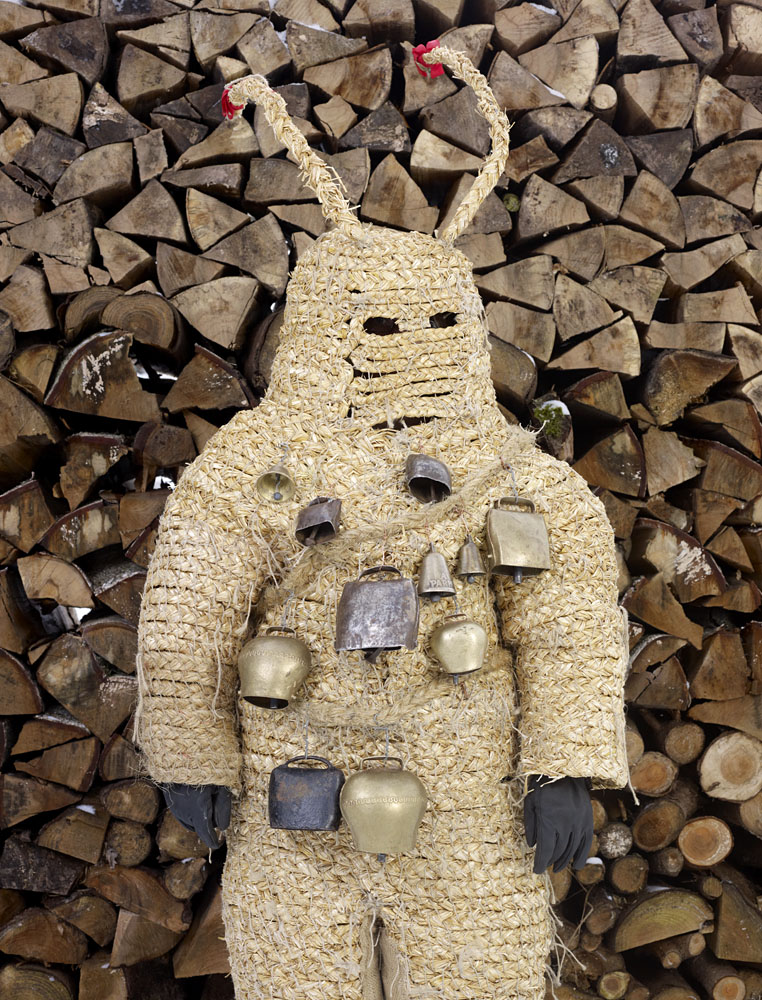
Charles Fréger (Pelzmärtle, Bad Herrenalb, Germany), Wilder Mann, 2010-2011
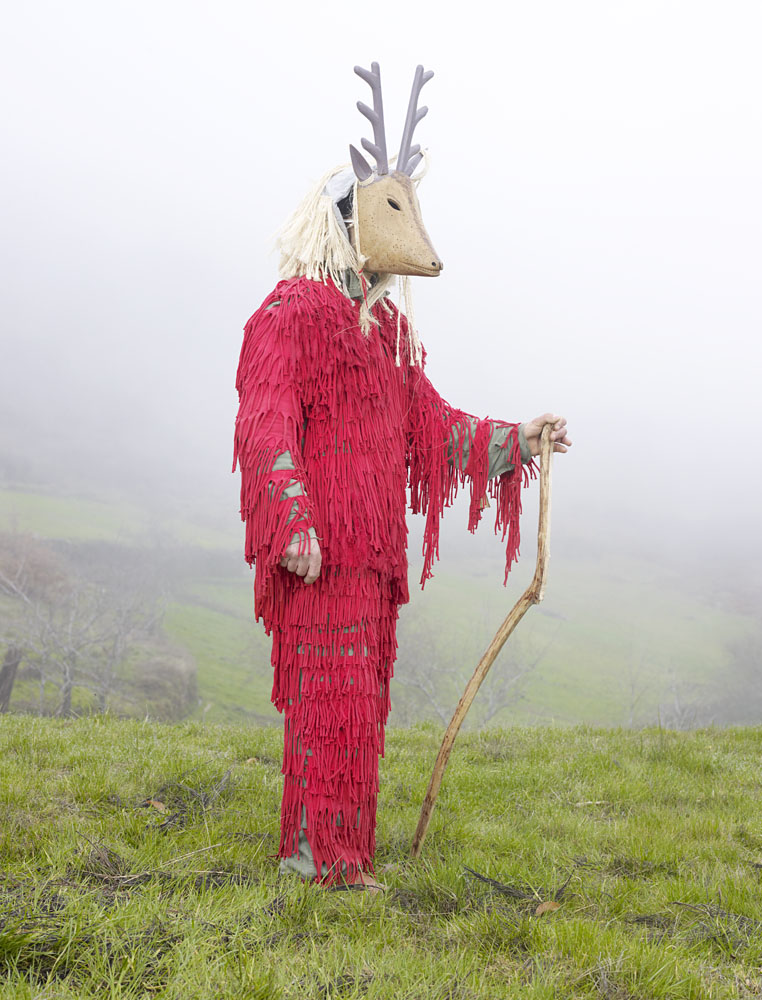
Charles Fréger, Wilder Mann (Caretos, Lazarim, Portugal), 2010-2011
One of the chapters of the biennale, The Eye in the Mask, brings side by side ethnographic masks with works of art by the CoBrA avant-garde and by contemporary artists. Putting a mask on alters your identity. You can become an animal, a monster, a deity or another, more powerful, more secretive being.
A whole room was filled with the engrossing photo series that Charles Fréger realized throughout Europe in search of the mythological figure of the Wild Man.
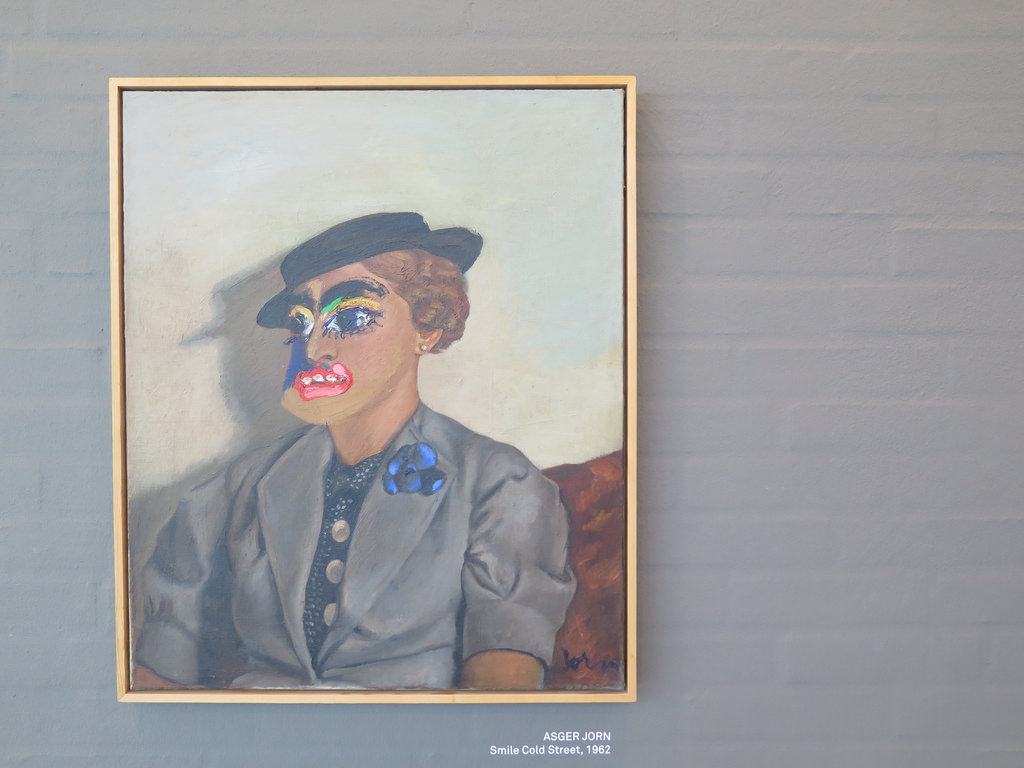
Asger Jorn, Smile Cold Street, 1962
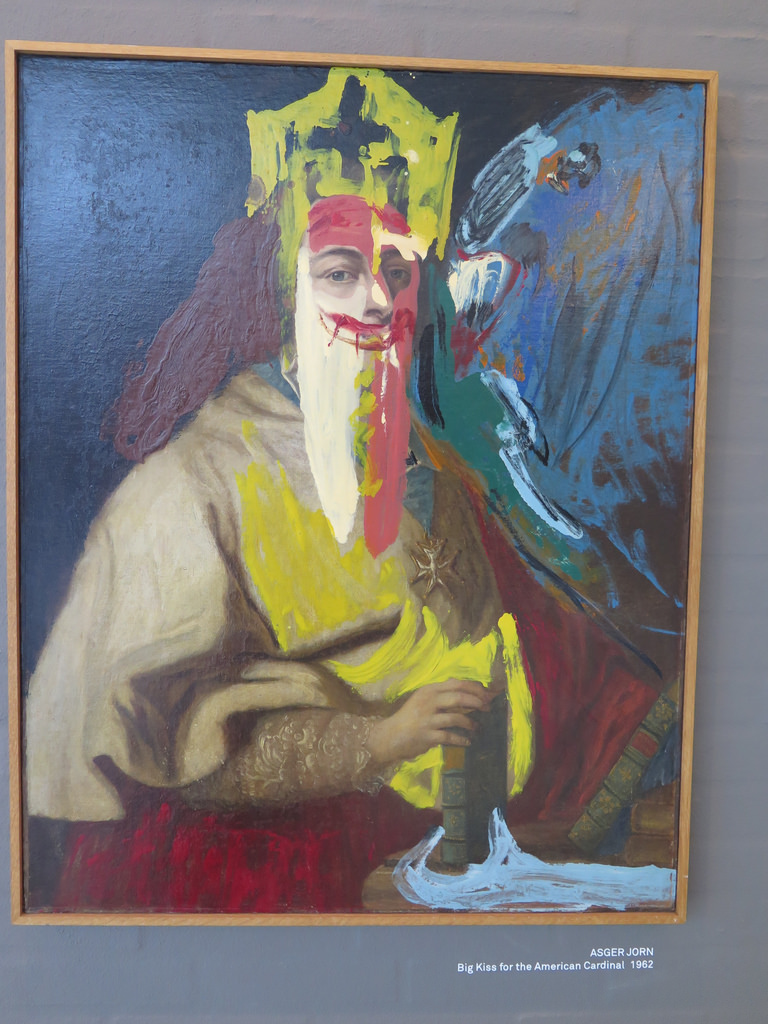
Asger Jorn, Big Kiss for the American Cardinal, 1962
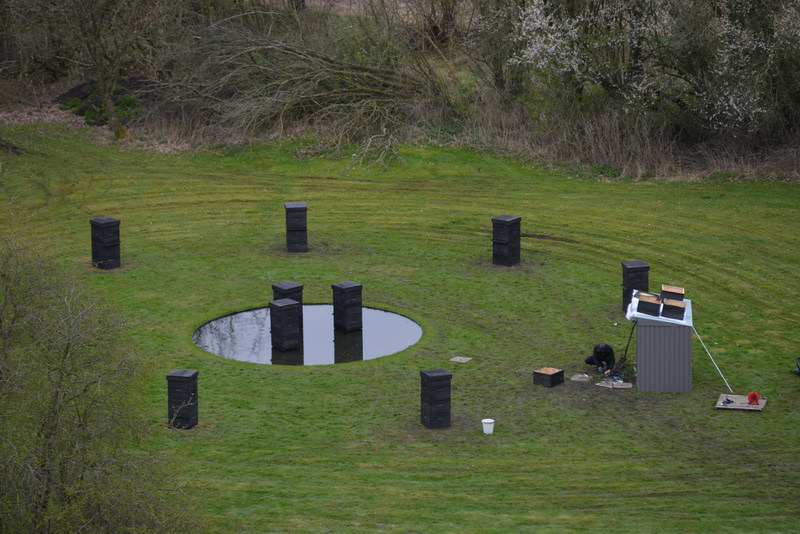
Céleste Boursier-Mougenot. Photo: Ole Jørgensen
There were chicken inside and outside the Herning Højskole, one of the main venues of the biennale. There were also bees in the adjacent garden. Céleste Boursier-Mougenot has installed burned-wood beehives and turned their activity into music. The sound is transmitted from the hives out into the landscape. By moving around the installation, you can modulate the composition.
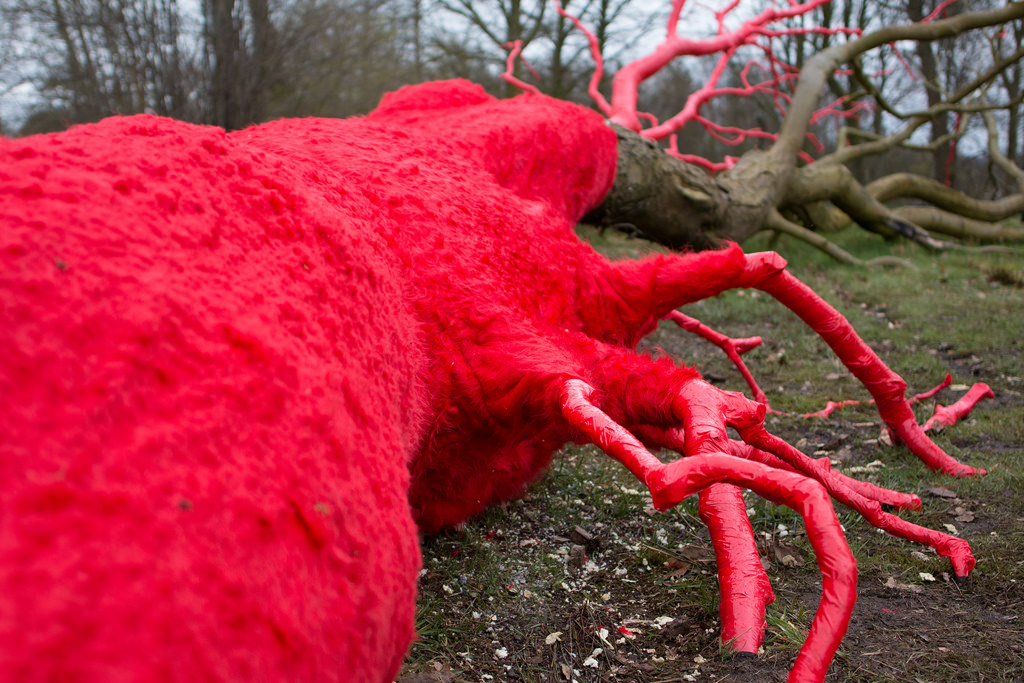
Mahza Karimizadeh, Rhizome. Photo: Jens Wolter
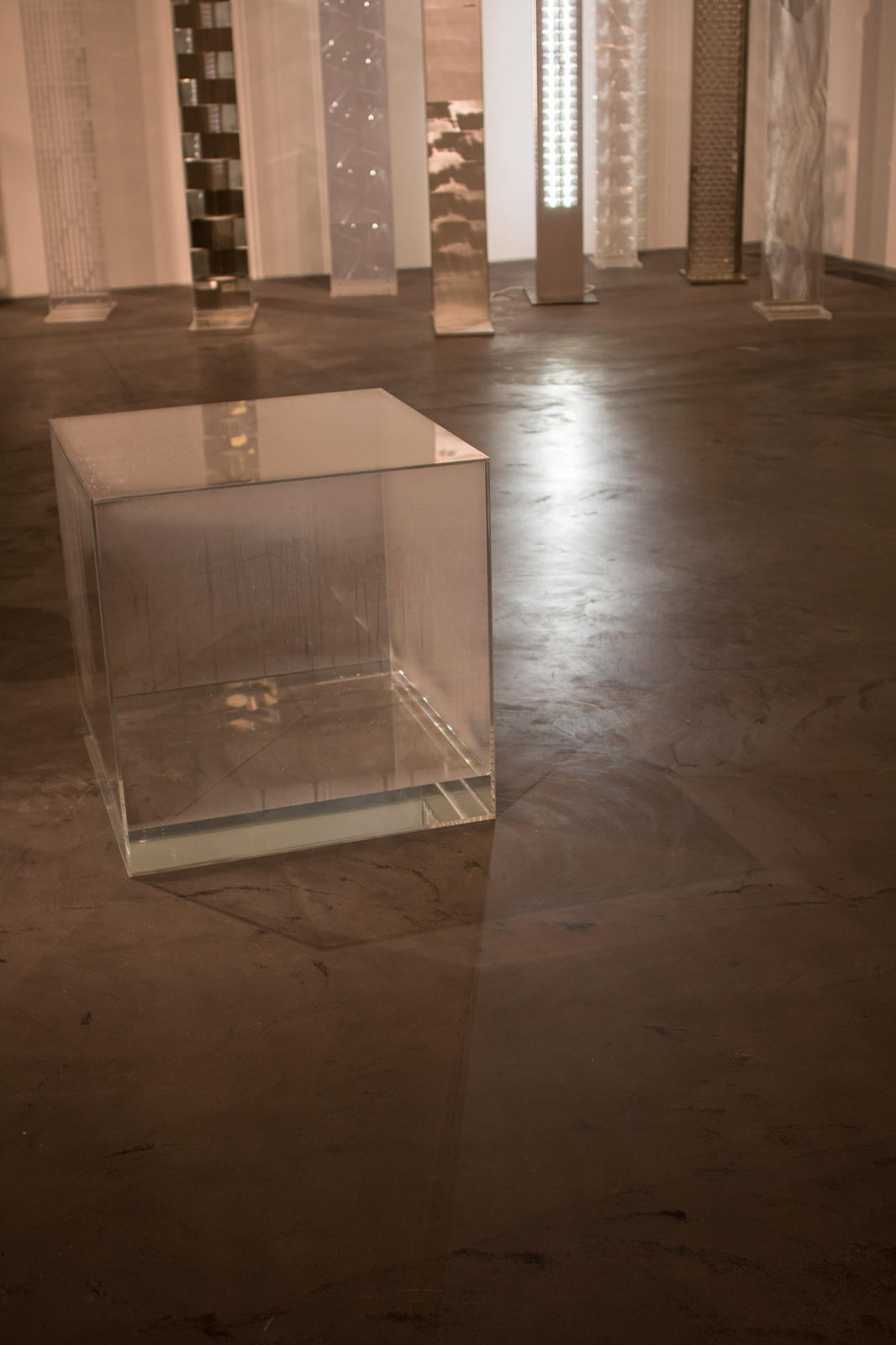
Hans Haacke, Kondensationswürfel (Condensation Cube), 1964. Reconstruction by ZERO foundation, 2017
Hans Haacke‘s transparent acrylic cube contains a small amount of water. Condensation begins to form and droplets run down the walls of the box, changing according to the ambient light and temperature. The work’s appearance therefore depends upon the environment in which it is placed. As Haacke explained in 1965: “The conditions are comparable to a living organism which reacts in a flexible manner to its surroundings. The image of condensation cannot be precisely predicted. It is changing freely, bound only by statistical limits. I like this freedom.”
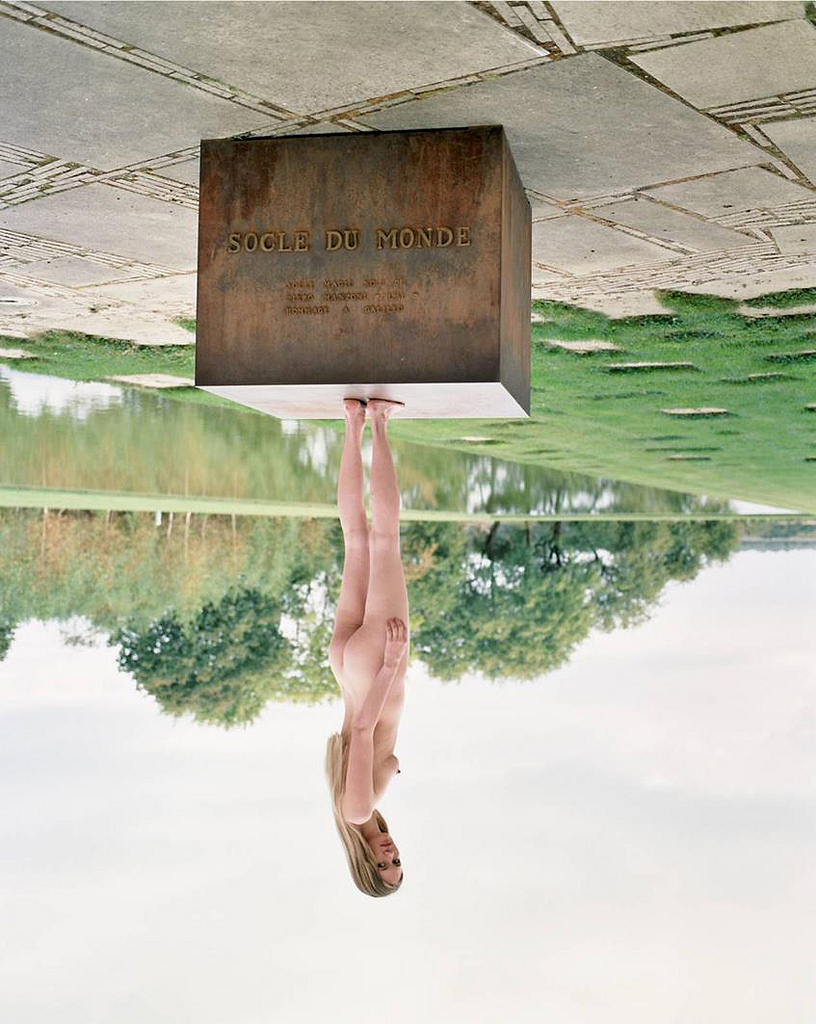
Spencer Tunick, Socle du Monde (Herning, Denmark) 2016, Courtesy of the artist
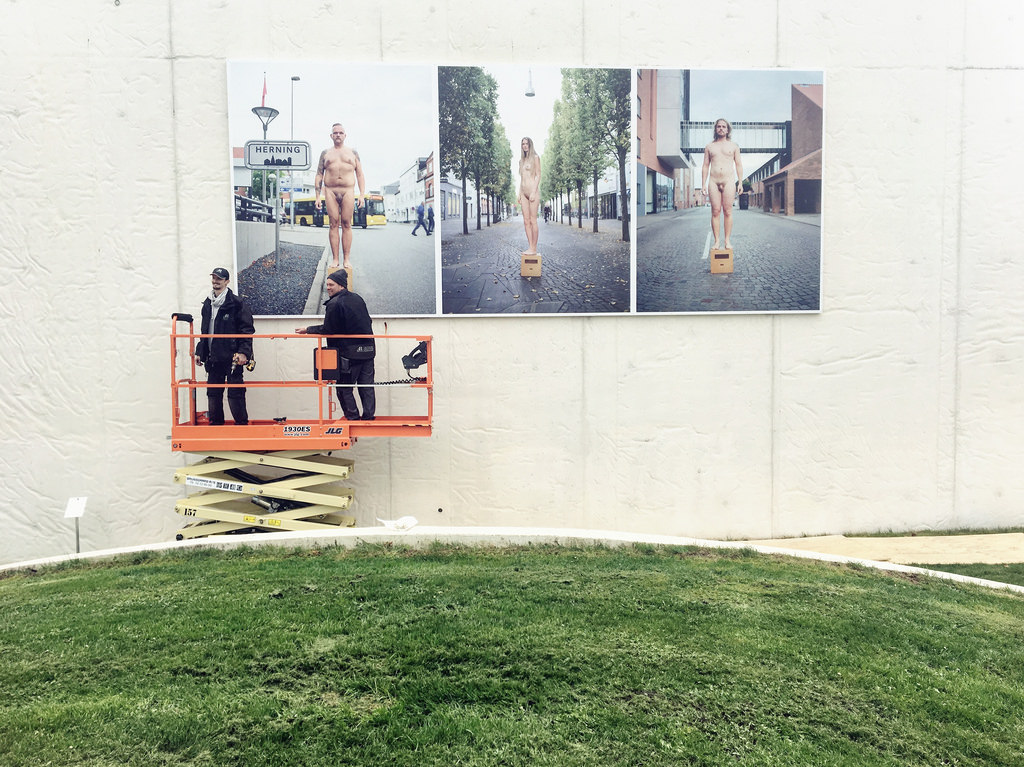
Spencer Tunick, Socle du Monde (Herning, Denmark) 2016. Photo: Jens Wolter
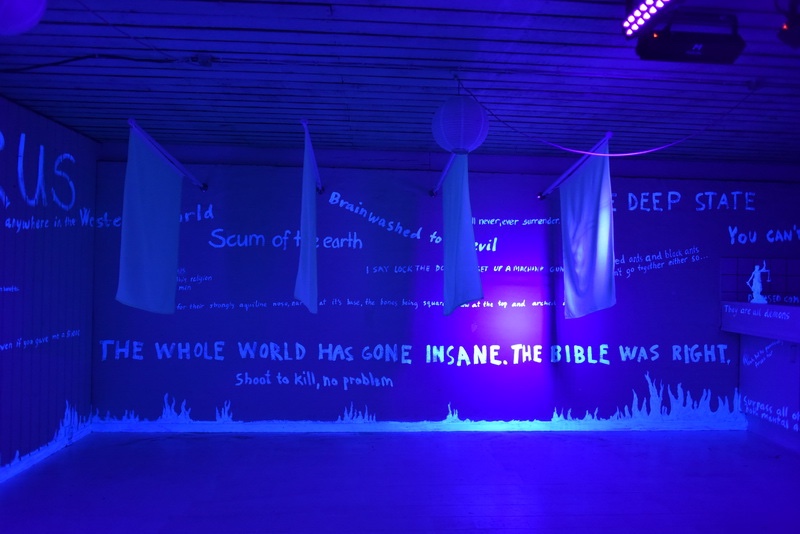
Hesselholdt & Mejlvang, The Invisible Territory, 2017, Socle du Monde Biennale. Photo: Ole Jørgensen
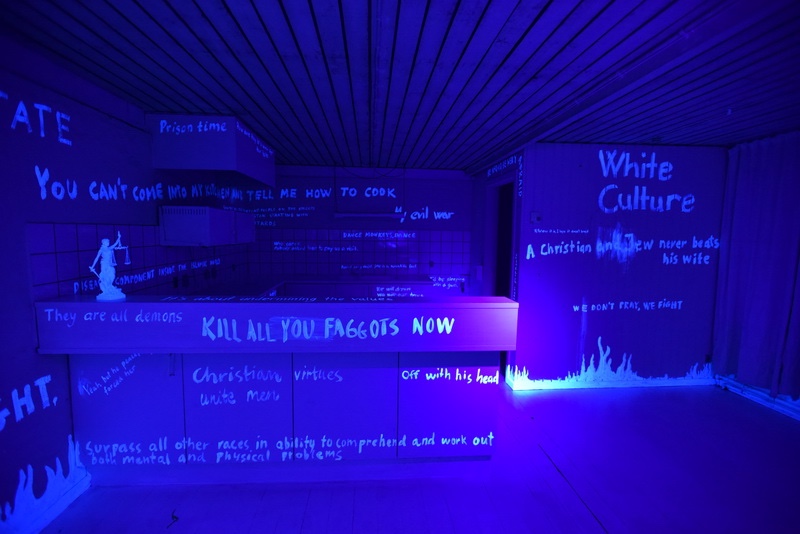
Hesselholdt & Mejlvang, The Invisible Territory, 2017, Socle du Monde Biennale. Photo: Ole Jørgensen
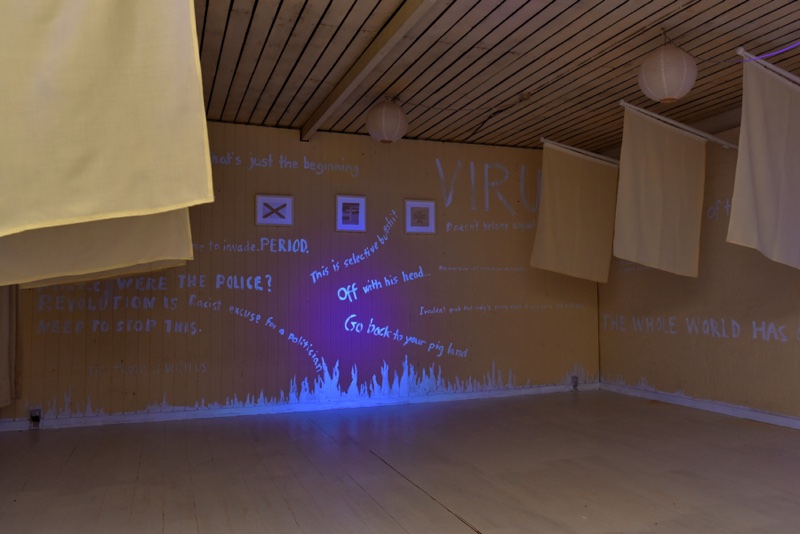
Hesselholdt & Mejlvang, The Invisible Territory, 2017, Socle du Monde Biennale. Photo: Ole Jørgensen
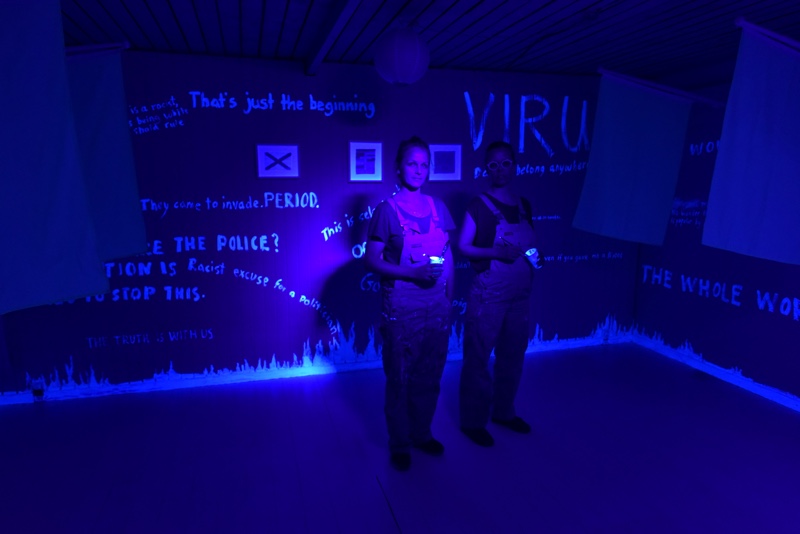
Hesselholdt & Mejlvang, The Invisible Territory, 2017, Socle du Monde Biennale. Photo: Ole Jørgensen
When you enter the rooms dedicated to Hesselholdt & Mejlvang‘s installation, you see a white floor, white walls, white furniture, white objects, etc. The space immediately evokes one of those ZERO experiments. But as soon as black light fills the room, heinous sentences cover all surfaces. “Go back to your pig land!” “They came to invade. PERIOD!” “Kill all you faggots now”, etc. The artists found these racist and bigoted sentences on online message boards and comment sections. The duo then copied them using luminous fluorescent paint. The effect is upsetting. You’re tempted to stay so that you can read everything but you are also compelled to get out of the room as quickly as possible such is the unpleasant effect that these words have on you.
The 2017 Socle du Monde Biennale – to challenge the Earth, the Moon, the Sun & the Stars remains open until 27 August 2017 at HEART – Herning Museum of Contemporary Art, Herning Højskole, Carl-Henning Pedersen & Else Alfelt’s Museum, The Geometric Gardens and HEART’s Sculpture Park. In Herning, Denmark.
My photos of the biennale are on flickr.

